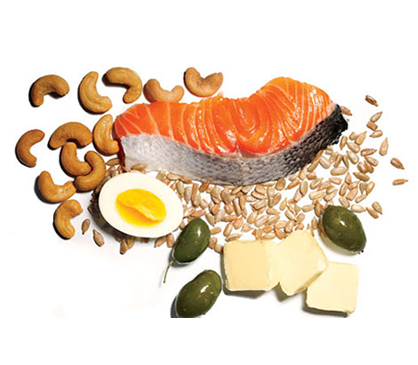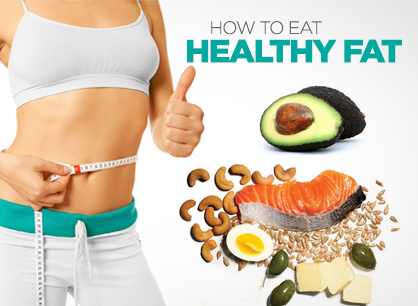Facts on Healthy Fats: Why They’re Important
Of all the nutrients the body needs, fat is definitely the one in need of some good PR. Did you know that the Center for Disease Control (CDC) recommends that 20 percent to 35 percent of our daily calories come from fats? Or that eating the right kinds can actually help to lose weight? Dieters often simply opt for low-fat everything and fail to address the big picture of their nutritional needs, which can be counterproductive in the long run. Are we telling you to eat fats? Yes. Are we giving you a green light to scarf that donut? No. Read on.
Fats are so important because they help to deliver key nutrients to the body. Vitamins A, D, E and K are all fat-soluble, meaning that they need to bind to fat to be properly absorbed. This means that you may be carefully choosing a high-nutrient meal with the best of intentions but, without fats, you won’t be fully reaping the benefits.
Additionally, many healthy fat sources take longer to digest, and can help you feel full and prevent you from snacking throughout the day. In fact, pairing fats with another commonly maligned nutrient, carbohydrates, in the same meal will help to keep blood sugar stable and ward off the extreme spikes and drops that cause feelings of hunger.

Despite these benefits of including fats in a well-balanced diet, low-fat and non-fat products are labeled as the healthy, “guilt-free” choices at the supermarket. Camille Macres, nutritional expert and founder of Recipe RX, claims that this spin could not be farther from the truth. She explains, “low-fat and fat-free foods are typically laden with chemicals, additives, and sugars to replace the fat,” and advises that it’s best to choose foods that are as close to their original form as possible. An interesting tidbit: CDC data shows that Americans consumed a lower percentage of calories from fat in 2000 than they did in 1971, but the total number of calories consumed by women per day increased by more than 300! This is likely correlated to the greater consumption sugars and other filler in non-fat foods.
So, what fats are best to eat and how much should we eat of them? Based on an 1,800-calorie diet, 20 to 35 percent works out to 40 to 60 grams of fat per day. Monounsaturated fats such as avocado, green olive and peanut butter are healthy choices that have been shown to lower cholesterol levels. Fats containing Omega-3 such as salmon and walnuts also have many documented benefits. Saturated fats often get a bad rap, but many are questioning negative claims about them (ie, links to heart disease), and sources such as lean ground beef and coconut oil in moderation can be part of a healthy diet.
As a general rule, the CDC recommends reducing the intake of calories from solid fats like butter and margerine, and replacing solids with oils where possible. Also, just say no to trans fats. Though companies can sometimes be tricky about labeling trans fats, anything with hydrogenated or partially hydrogenated oils is a culprit.
.png)
To help get on the right track, Macres shared a sample meal plan for eating the right healthy fats and a tasty aioli recipe from her new book, “Paleogasm.”
MEAL PLAN
Breakfast: Organic egg scramble cooked with pasture butter, assorted veggies and avocado slices.
Lunch: Seared wild salmon salad with olive oil vinaigrette, assorted salad veggies and olives.
Dinner: Grass-fed burger with homemade garlic aioli, salad and avocado slices
.png)
BASIC AIOLI
Source the best ingredients, and aioli (French for garlic mayonnaise) becomes a true superfood. I don’t personally like the taste of straight olive oil, unless you can find a very mild one. I love ½ pecan oil and ½ olive oil. Avocado and macadamia nut oil are healthier choices, but have not tried them in this recipe. Coconut oil is the healthiest choice, but it will make for a very firm aioli once chilled. Buy the best eggs you can find, use fresh garlic, and eat with EVERYTHING!
1 cup healthy oil blend (see notes above)
3 egg yolks
2 cloves garlic
1 tablespoon dijon mustard
1 tablespoon lemon juice
1 teaspoon + more to taste
In a small food processor, chop garlic. Add egg yolks, lemon juice, dijon mustard, and a teaspoon salt and blend about a minute. The yolks will become creamy in color. Slowly drizzle in oil blend in opening above (all small food processors should have this for this very purpose). The aioli should be very thick and well combined. Taste for salt. You can also add more lemon or dijon if you desire.
Variations:
Buffalo Aioli: Add 1 part sriracha and 1 part white wine vinegar for every 4 parts basic aioli.
Jalapeno Lime Aioli: Add ½ fresh jalapeno to basic recipe with garlic. Swap lime juice for lemon juice.
Moroccan Aioli: Swap 2 teaspoons Moroccan Spice Blend for 1 teaspoon salt in basic aioli. Season with salt to taste.
Lemon Aioli: Increase lemon juice to 2 tablespoons and add 2 teaspoons lemon zest.
For many more of Macres’ great recipes, buy “Paleogasm”
Read more LUX Health.
Tagged in: wellness, food, nutrition, health, healthy fats, paleogasm,




